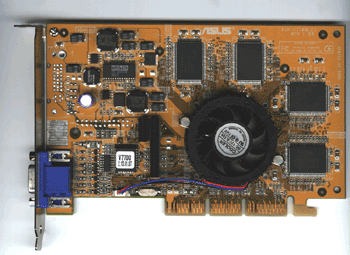
Original Link: https://www.anandtech.com/show/544
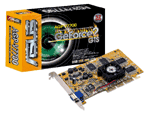 With
the release of the GeForce 2 GTS it seems that NVIDIA has finally nailed their
product release cycle down. Similar to the way video card manufacturers responded
to announcement of the GeForce 256 chip, almost every major video card manufacturer
has announced GeForce 2 GTS based cards. Unlike the GeForce 256, however, this
time the cards are actually getting into the consumer's hands. The lag that
was present between chip announcement and consumer use in the case of the GeForce
256 is all but gone now: consumers can readily purchase one of these powerhouse
cards a mere few weeks after the chip's announcement.
With
the release of the GeForce 2 GTS it seems that NVIDIA has finally nailed their
product release cycle down. Similar to the way video card manufacturers responded
to announcement of the GeForce 256 chip, almost every major video card manufacturer
has announced GeForce 2 GTS based cards. Unlike the GeForce 256, however, this
time the cards are actually getting into the consumer's hands. The lag that
was present between chip announcement and consumer use in the case of the GeForce
256 is all but gone now: consumers can readily purchase one of these powerhouse
cards a mere few weeks after the chip's announcement.
Not only is this exciting on the consumer front, with new technology easily obtainable and competition on the rise, it is also exciting on the manufacturer's level. In a shotgun approach, almost every video card manufacturer has run out in an attempt to be one of the first GeForce 2 GTS based cards on the market. Due to this, it is necessary for a card manufacturer to do everything in their power to set their product apart from the rest of the reference design world, as we have seen with other GeForce 2 GTS cards out there. With the release of their newest video card, the GeForce 2 GTS based V7700, ASUS has done what other manufacturers are doing in order to prevent total annihilation in this new market: adding additional features. ELSA has done this with the GLADIAC and its impressive 6-year warranty as well as the Best Select software bundle. It appears that Hercules plans to do this with RAM heatsinks on the 3D Prophet II. GTS. How does ASUS plan to ensure success? Let's take a look at what it is about this card that allows it to stand out from the reference design board as well as how the card rates overall.
|
Highlights |
|
Powered
by the world's first per-pixel shading Graphics Processing Unit:
NVIDIA GeForce 2 GTS |
|
Built-in
32 MB DDR video memory with up to 5.3 GB/sec bandwidth:
Provides more resolutions and color depths |
|
Dual-texture
pixel-fill capacities with four new Hypertexel pipelines:
Sets a new milestone for realism |
|
1.6
Gtexel fill rate, 25 Mtriangles/sec through T&L/setting:
Performs up to 3x improvement over GeForce |
|
ASUS
SmartDoctor Technologies:
Provide the greatest security to your valuable system |
|
Optimized
for DirectX 7 and OpenGL features:
Ensures broad application support |
Features
- AGP 4x/2x with Fast Writes
- Four new Hypertexel pipelines process two texture per pixel, in true color, at full speed up to 1.6 Gtexel fill rate
- Built-in 32 MB high speed DDR video memory with up to 5.3 GB/sec bandwidth
- Eight texture mapped, lit pixels per clock cycle
- Second generation Transform and Lighting (T&L) Engine
- Up to 25 million triangles per second at peak rates
- Optimized for Direct3D acceleration with complete support for DirectX 7 features such as multi-texturing, bump mapping, light maps, reflection maps, full scene anti-aliasing, trilinear and 8-tap anisotropic filtering (better than trilinear mipmapping)
- Fully 1.2 compliant OpenGL support
- 32-bit colors, Z/stencil buffer
- Multi-buffering (double, triple, quad buffering) for smooth animation and video playback
- Multiple video windows with hardware color space conversion and filtering (YUV 4:2:2 and 4:2:0)
- Integrated 350 MHz RAMDAC supporting from 640x480 up to 2048x1536 in true color
- BRDF (Bidirectional Reflectance Distribution Function) support
- Video acceleration for Direct Show and MPEG-1, MPEG-2, and Indeo
- SmartDoctor Technologies with fan RPM monitoring, AGP power level monitoring, over-heat protection, and dynamic overclocking
- Software bundle including ASUSDVD 2000, Darkan, Rollcage, and 12 other game demo
|
Refresh Rate Support |
||
|
Resolution |
Color |
Max Refresh Rate (Hz) |
|
640 x 480 |
256/65K/16M |
60 - 240 |
|
800 x 600 |
256/65K/16M |
60 - 240 |
|
1024 x 768 |
256/65K |
60 - 240 |
|
1024 x 768 |
16M |
60 - 200 |
|
1152 x 864 |
256/65K |
60 - 200 |
|
1152 x 864 |
16M |
60 - 170 |
|
1280 x 960 |
256/65K |
60 - 170 |
|
1280 x 960 |
16M |
60 - 150 |
|
1280 x 1024 |
256/65K |
60 - 170 |
|
1280 x 1024 |
16M |
60 - 150 |
|
1600 x 900 |
256/65K |
60 - 150 |
|
1600
x 900
|
16M
|
60
- 120
|
|
1600
x 1200
|
256/65K
|
60
- 120
|
|
1600
x 1200
|
16M
|
60
- 100
|
|
1920
x 1080
|
256/65K
|
60
- 100
|
|
1920
x 1080
|
16M
|
60
- 85
|
|
1920
x 1200
|
256/65K
|
60
- 100
|
|
1920
x 1200
|
16M
|
60
- 85
|
|
1920
x 1440
|
256/65K
|
60
- 85
|
|
1920
x 1440
|
16M
|
60
- 75
|
|
2048
x 1536
|
256/65K
|
60
- 75
|
|
2048
x 1536
|
16M
|
60
|
The Card
Unlike the original GeForce 256 based card that ASUS produced, the V6600 SDRAM, the V7700 does not use a pure reference design but rather a slightly modified version. The V6600 SDRAM was solely a reference design based board: that was it. It was not until the V6600 Pure came along did we see ASUS stray from the reference design and produce a proprietary design capable of including advanced features such as video-in and hardware monitoring. With the V7700, ASUS's entrance into the GeForce 2 GTS market is slightly different: although the card is based on the NVIDIA reference design, it incorporates a hardware monitoring chip into free space on the back of the PCB. This feature alone provides the extra edge we spoke of earlier, keeping ASUS afloat in the GeForce 2 GTS market.
Powered by the same Winbond
W83781D chip found on the V7700's younger brothers, the V6x00 series cards,
the V7700 is able to decode information sent to it by not only the hardware
monitoring fan but also from an internal temperature probe and voltage monitor.
As far as we have seen in the lab, ASUS is the only manufacturer to implement
such a feature in a GeForce based card. The importance of hardware monitoring
can not be understated: not only does the Winbond chip allow for dynamic overclocking
by raising core and 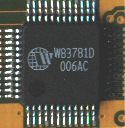 memory
speed until the card gets too hot, it also allows for a watchful eye to be kept
on the fan speed preventing disaster. It took a proprietary board design to
do this with the V6x00 series card, but this design also allowed for video-in
to be implemented. In the case of the V7700 series cards, it has yet to be seen
if the upcoming V7700 Deluxe will continue to stick to the reference design,
but it seems highly likely: the only reason that the reference design was not
used in the case of the V6x00 series was because there needed to be space for
the hardware monitoring chip as well as the video-input chip. Since ASUS has
found a way to mate the Winbond W83781D chip onto free space on the back of
the reference design, and since video-in and video-out are both controlled by
a snap on daughter card, it seems unlikely that a new design needs to be made.
It is much simpler for ASUS to stick with the reference design with the Winbond
chip on the back and design a video-in/out daughter board by themselves, making
this the most likely scenario.
memory
speed until the card gets too hot, it also allows for a watchful eye to be kept
on the fan speed preventing disaster. It took a proprietary board design to
do this with the V6x00 series card, but this design also allowed for video-in
to be implemented. In the case of the V7700 series cards, it has yet to be seen
if the upcoming V7700 Deluxe will continue to stick to the reference design,
but it seems highly likely: the only reason that the reference design was not
used in the case of the V6x00 series was because there needed to be space for
the hardware monitoring chip as well as the video-input chip. Since ASUS has
found a way to mate the Winbond W83781D chip onto free space on the back of
the reference design, and since video-in and video-out are both controlled by
a snap on daughter card, it seems unlikely that a new design needs to be made.
It is much simpler for ASUS to stick with the reference design with the Winbond
chip on the back and design a video-in/out daughter board by themselves, making
this the most likely scenario.
The .18 micron GeForce 2 GTS GPU is cooled via a circular heatsink and fan. Although the fan may look dramatically different that those found on most GeForce 2 GTS cards, the idea behind it and the functionality of the heatsink remain the same. In fact, it seems that the surface area of the circular heatsink may actually be smaller that of the generic square heatsinks. The heatsink is attached to the GPU surface via a properly applied layer of thermal grease, allowing for maximum heat transfer. Unlike the GeForce 256, heat is not a major concern for GeForce 2 GTS cards due to the .18 mircon die used in the chip, as described in the overclocking section. With this in mind, the heatsink and fan combination used in the V7700 is very similar to others out there, with the added bonus that the V7700 uses thermal grease not less efficient thermal glue found in the majority of video cards out there.
The DDR SGRAM chips are
the same ones found on all other 32 MB GeForce (256 or 2 GTS) DDR cards. Running
at a default speed of 333 MHz, the Infineon chips are actually clocked at their
speced speed. As discussed in our ELSA GLADIAC GeForce 2 GTS review, it seems
that Infineon has finally met speced ratings when it comes to memory quality.
The GeForce 256 memory clock was set at 300 MHz (150 MHz DDR) even though the
RAM 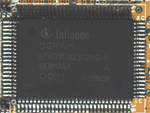 was of the same
brand and speed as found on GeForce 2 GTS cards. We often had problems overclocking
the memory clock above the 166 MHz DDR mark, suggesting that NVIDIA would stray
away from this number when setting the GeForce 2 GTS memory clock speed. As
it turns out, the new batches of Infineon RAM found on GeForce 2 GTS cards consistently
perform better than the same type RAM chips on older GeForce 256 cards. How
much better is left to be seen in the overclocking section, but at least we
know that the RAM should have no problem running at its speced speed of 166
MHz.
was of the same
brand and speed as found on GeForce 2 GTS cards. We often had problems overclocking
the memory clock above the 166 MHz DDR mark, suggesting that NVIDIA would stray
away from this number when setting the GeForce 2 GTS memory clock speed. As
it turns out, the new batches of Infineon RAM found on GeForce 2 GTS cards consistently
perform better than the same type RAM chips on older GeForce 256 cards. How
much better is left to be seen in the overclocking section, but at least we
know that the RAM should have no problem running at its speced speed of 166
MHz.
As far as video-out goes, it does not come with the card nor does it appear that an upgrade will be available. Even though adding video out would be as simple as snapping a daughter board in place, ASUS did not precut a hole for the S-Video connector into the mounting bracket of the card. This suggests that ASUS wishes to target the V7700 at users who have no need for video out, leaving the higher costing V7700 Deluxe to fill the needs of both video-out as well as video-in users.
Overclocking
As can be expected with almost all GeForce 2 GTS cards, the ASUS V7700 responded to overclocking very well. The nature of the GeForce 2 GTS makes it an excellent overclocking chip due to the .18 micron fab used in the chip's manufacture. What this translates to is lower resistance in the chip which results in less heat dissipation. Due to this, the heatsink and fan combination used by a GeForce 2 GTS card no longer plays the vital role it played in the .22 micron GeForce 256. Therefore, instead of cooling playing the most important role in overclockability, transistor conductivity (often referred to as chip quality) seems to play the most vital role. Transistor conductivity, a function of the ratio between the transistor length and width, varies during the fabrication process causing variations in the maximum overclocked speed that a chip can reach. Both card manufacturers and consumers do not know what quality the chip used in a particular card is, therefore the variation in overclockabilty between GeForce 2 GTS cards can not be predicted. This serves to explain why, although the V7700 is cooled with the use of more efficient thermal grease, it remains behind the thermally glued ELSA GLADIAC as far as maximum core speed goes. The ASUS was able to obtain a core speed of 235 MHz, 35 MHz above stock speed. The GLADIAC, on the other hand, was able to beat the V7700 by 5 MHz with a core clock speed of 240 MHz. Both speed are extremely acceptable, resulting in very fast cards.
Once again when overclocking the memory clock we find that chip quality (transistor conductivity) plays a vital role. Both the ASUS V7700 and the ELSA GLADIAC use 6 ns Infineon SGRAM chips. As we discussed earlier, these RAM chips are obviously superior to those found in earlier GeForce 256 DDR based cards simply due to the fact that they can readily obtain the speed at which they are rated: 166 MHz DDR. When overclocking, the chips exceed any speed found in GeForce 256 based cards, with the ASUS V7700 able to get to a maximum memory clock speed of 363 MHz, 30 MHz over stock. This varies slightly from the 375 MHz memory clock obtained with the ELSA GLADIAC, but once again keep in mind that this is not a function of the video card itself but rather of the RAM batch used in the card. With a total overclocked speed of 235/363 MHz, we had one of the fastest cards AnandTech has ever seen.
The Drivers
When ASUS designed a driver set they liked, they stuck with it. It really only makes sense: why waste the time and money designing a new driver interface for the same base system, the NVIDIA reference drivers? With this in mind, ASUS is sending out the V7700 with a 5.16 based version of their ASUS driver set found on all V6x00 series cards. The functionality of the drivers is very similar to the reference driver set with the addition of many cosmetic changes. The drives come with your standard taskbar resident utility and tweaking screens as well as with ASUS's Tweaking Utility that allows for card overclocking. The one problem with having such a feature rich driver set spread across a platform is that the drivers often include features which a specific card does not have. This is the case with the V7700, as the driver set includes such advanced features as video-in tweaking, VR adjustment, and video-out color, all features that the V770 lacks. As the features loom over your head, it leaves the user wanting more: mainly the V7700 Deluxe when it comes out.
To interpret the information the card receives via the Winbond W83781D chip, ASUS uses its own SmartDoctor utility. Below is an except from our ASUS V6800 Deluxe review, a card which utilizes the same utility:
One of the best driver features of the [V7700] is the packaged Smart Doctor software. This software takes the information sent to it by the Winbond W83781D chip and displays it very intuitively on the screen. Easily seen in graph type views, the current fan RPM, core temperature, and core voltage are displayed. In addition to these features of the Smart Doctor software, it also includes some very cool overclocking functions. The card features what ASUS calls dynamic overclocking. What this feature does is change the clock speed when needed. For example, when in Windows the clock speed jumps down to a comparatively slow 86 MHz core speed and 82 MHz memory speed. These speeds are adjusted to higher levels when the video card is taxed, for example in any 3D games or programs. Also included is an overheat protection feature that prevents the chip from being clocked too high. If the internal temperature sensor reads that the chip is too hot, the dynamic clock function steps in and clocks down the card, resulting in a lower running temperature.The one complaint we have with the Smart Doctor software is that it constantly switches focus to the program if a problem is detected. While this may make sense intuitively, problems can be run into if, for example, your motherboard does not put out exactly the correct voltage. You may not notice the problem but Smart Doctor will, and it will continue to notify you by switching focus to the program. This feature, in Quake III Arena, results in a white box flashing on the screen every 5 seconds (or for the time interval you have the monitoring at) and disappearing. In programs where focus can be switched (a feature which Quake III has left out), the game will minimize and Smart Doctor will appear. Quite annoying if you know of the problem and know that it is not really an issue.
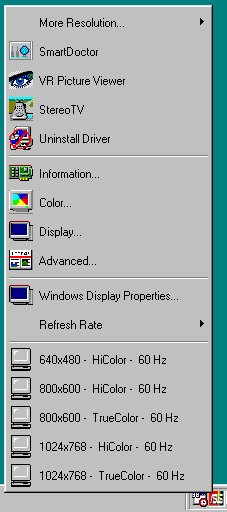
The taskbar allowed us to
change settings at a the click of a mouse.
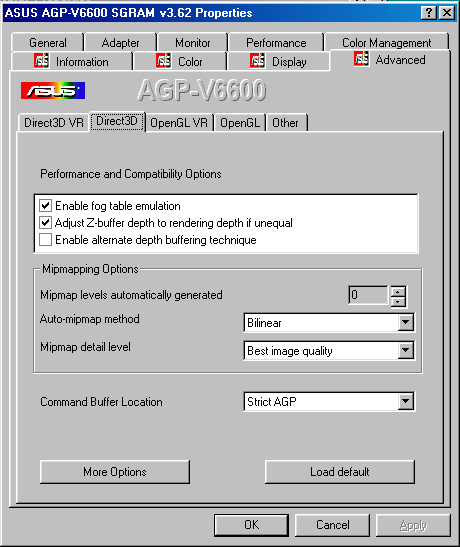
D3D settings were easy to
find and tweak.
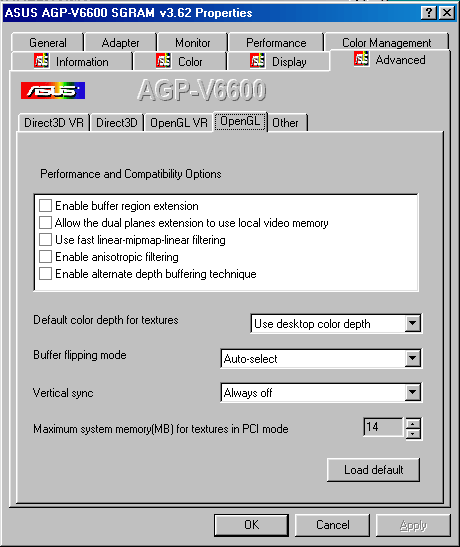
OpenGL settings could be modified easily as well.
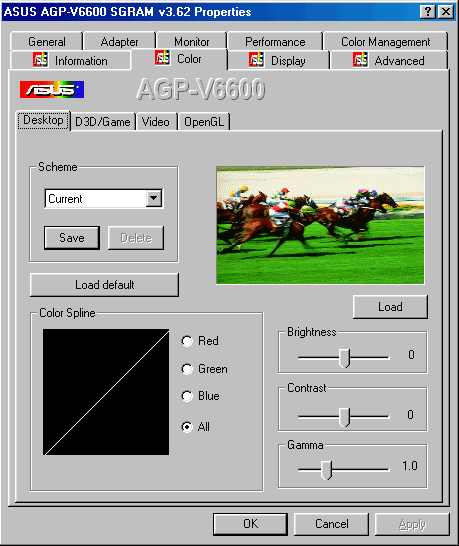
The desktop color tweaking utility.
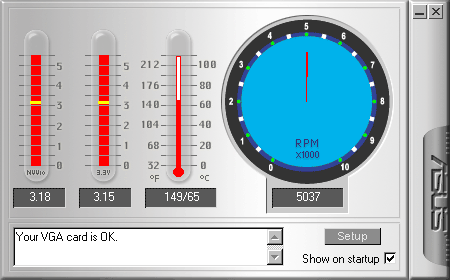
The Smart Doctor utility can be very useful for proper monitoring of the card.
The Test
|
|
Windows
98 SE Test System
|
|
|
Hardware
|
|
CPU(s) |
Intel
Pentium III 750E |
| Motherboard(s) |
ABIT
BF6
|
| Memory |
128MB PC133 Crucial Technology SDRAM |
| Hard Drive |
Quantum Fireball CR 8.4 GB UDMA 33 |
| CDROM |
Acer 24x |
| Video Card(s) |
ASUS V7700 |
|
|
Software
|
|
Operating System |
Windows 98 SE |
| Video Drivers |
|
|
|
Benchmarking Applications
|
| Gaming |
GT
Interactive Unreal Tournament 4.04 UTbench.dem |
Quake III Arena Performance- demo 001
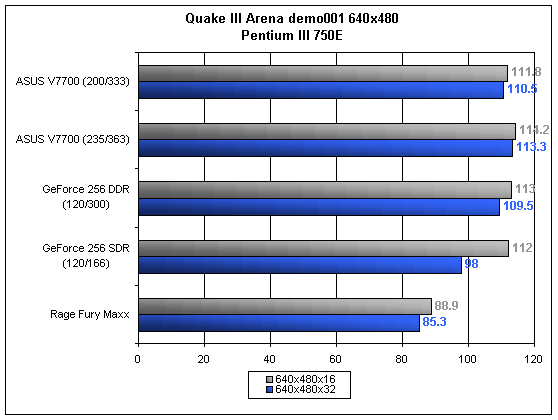
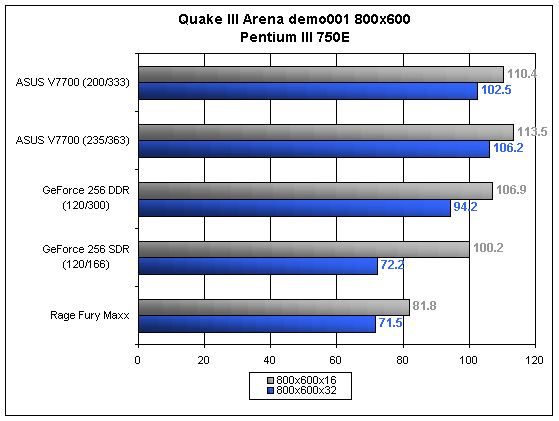
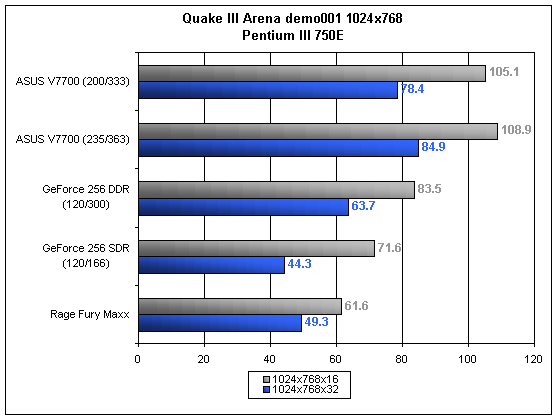
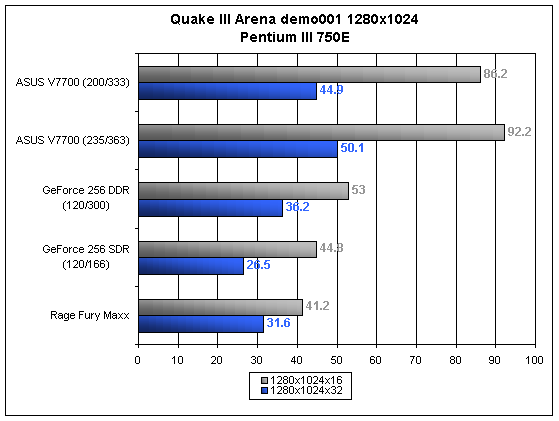
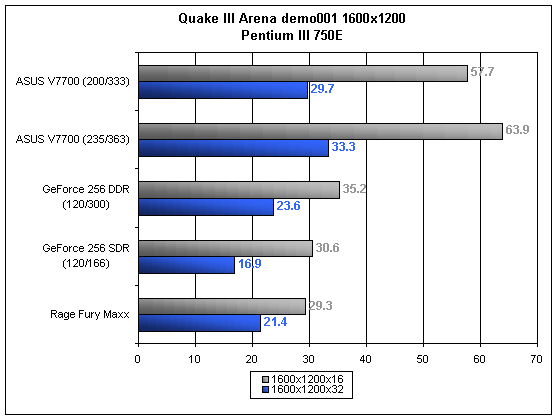
As with other GeForce 2 GTS based cards, the ASUS V7700 rocks. In Quake III demo001 the true power of the card begins to be seen at 800x600x32. Below this resolution, the limiting factor is not so much the raw video processing power but other factors, as can be seen with the relatively similar scores between cards under this resolution. Above 800x600x32, the ASUS V7700 is able to excel and continues to build speed al the way through 1600x1200x32. At these taxing resolutions, the GeForce 2 GTS's superior processing capabilities allow it to stand out from the rest of the processors out there. At the resolution of 1600x1200x16 the ASUS V7700 performs 64% faster than a DDR GeForce card. It is not only at this resolution that the card excelled: this margin of difference was not uncommon at and above 800x600x32.
It is easy to notice that the largest margins of difference occur in 16-bit color mode and not at 32-bit. This is due to the memory bandwidth limitations found on the GeForce 2 GTS. While the GPU may be capable of pumping out x number of frames per second, these frames need to be read into and out of memory in order to place an image on the screen. When using 32-bit color, more data needs to be moved into and out of the relatively slow memory pipeline, creating a bottleneck.
Quake III Arena Performance- Quaver
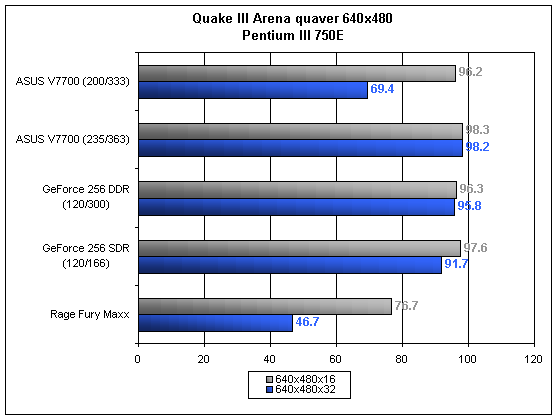
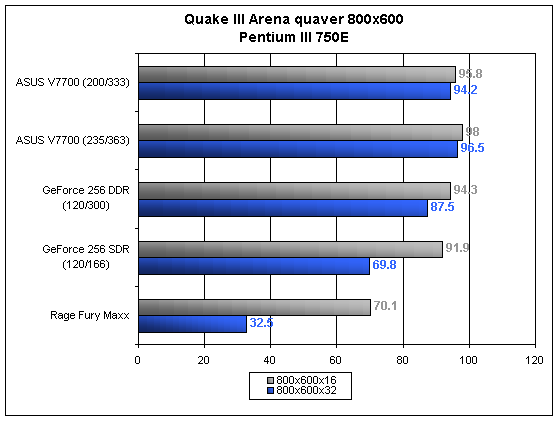
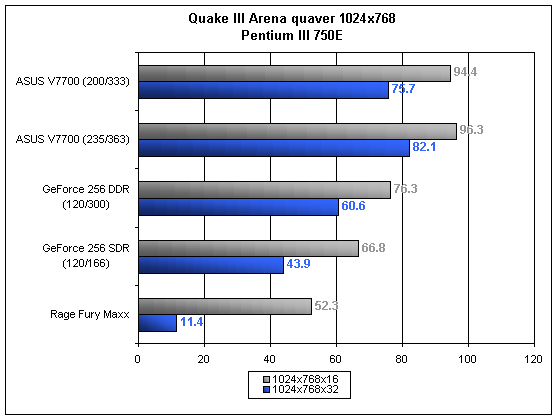
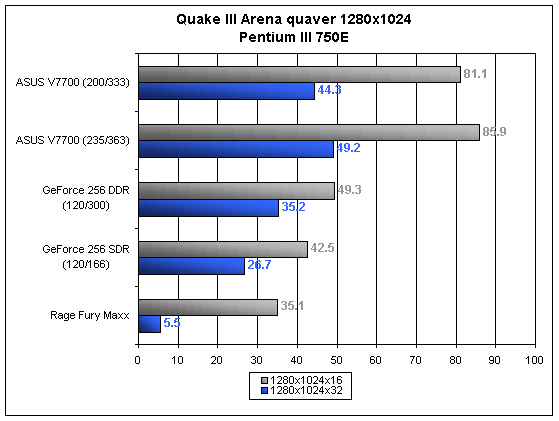
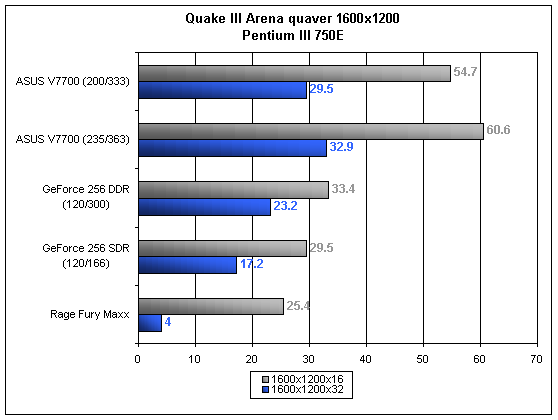
Unlike in previous benchmarks, quaver no longer kills the 32 MB GeForce cards. This is due to the use of 5.16 drivers during testing. These drivers allow for S3TC compression when in Quake III, thus texture swapping is no longer an issue because a full frame can fit in memory. The maximum performance gain is 65% when at 1280x1024x16 compared to a GeForce DDR, showing how the GeForce 2 GTS remains king of the hill. When overclocked this difference jumps to a rather large 74% increase in speed.
The quaver map is an example of one of the most stressful scenarios in Quake III Arena, making it a good place to judge maximum playable resolution. Many have their own option of what the minimum frame rate of a game should be, but subjectively about 50 FPS is adequate for the vast majority of users. With this in mind we see that Quake III Arena can easily be played on a GeForce 2 GTS at 1024x768x32 (with excessive speed) and can almost hit 1280x1024x32. At 44.3 FPS at 1280x1024x32, some items may appear a slight bit jumpy, however in the majority of cases the card should perform fine. The FPS jumps even higher when overclocked and 1280x1024x32 becomes even more accessible with a FPS speed of 49.2. At 1280x1024x32, Quake III Arena looks great, making the GeForce 2 GTS even more appealing.
Unreal Tournament Performance

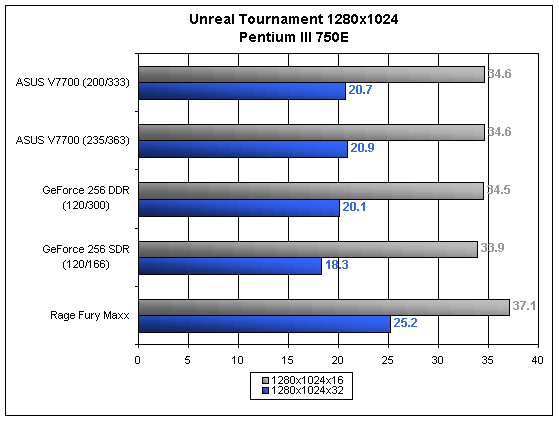
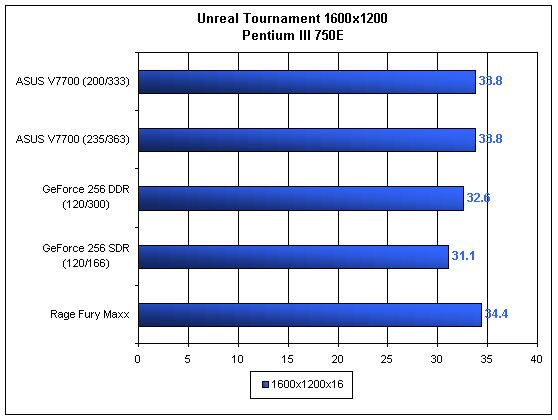
As we have seen many times in the past, the Unreal Engine does not show any video card scaling. Very little difference is noted between GeForce cards, with the exception of one resolution: 1280x1024x32. Here the GeForce SDR is crippled by its slow memory bus, as at such a high resolution and color set the game is relying on moving textures into and out of the memory at high speeds. This explains the results of the benchmark at this resolution: fastest performance comes from the card with the fastest memory clock, the GeForce 2 GTS.
Conclusion
So, you are on the market for a new video card. As far as you are concerned, only the GeForce 256 DDR and the GeForce 2 GTS are processors capable of powering your intense gaming addiction. Swaying towards the GeForce 2 GTS due to its insane speed and new release, you are shocked by the availability of GeForce 2 GTS based cards. The question remains: which card to pick? As little as one week ago, the decision would have been easy: the ELSA GLADIAC simply due to the fact that it was the only GeForce 2 GTS card out there. Now, with GeForce 2 GTS products coming almost weekly, the decision on one card is only getting harder. Unfortunately we are here to tell you that the entrance of the ASUS V7700 did not make the decision any easier.
With a sticker price of 349.99, the V7700 is priced along side with its main competitor, the ELSA GLADIAC. The software bundle of the V7700 is a bit weak, featuring the same 2 games and software DVD decoder as found in the earlier V6600 cards. These games remain for the most part useless for such a powerful video card. In addition do not let the "12 game titles" tag on the box fool you: these are 12 game demos. 2D image quality is what we expect of a GeForce card, meaning that it is roughly equivalent to the ELSA GLADIAC 2D wise.
What the V7700 lacks in software bundle it makes up for with hardware monitoring. By embedding a Winbond chip to an unused portion of the card, ASUS has produced a power computer user's dream. No more guessing how hot your chip is running using your finger or estimating the RPM of the fan by counting the number of times it spins per second. All this information and more can be found at the very useful SmartDoctor utility. Also included with this utility is a dynamic overclocking option which clocks down the core and memory speed when idle and cranks the speed back up when it is needed.
The choice of which GeForce 2 GTS card to get now is a tough one that depends on your personal preferences. If you plan to keep your video card for a long time and would like the reassurance of a 6-year warrantee, the ELSA GLADIAC is the card for you. In addition, the custom software bundle is good for those who are lacking 3D games now. On the other hand, if you are a power user who wants to be able to experience the greatest level of tweakabilty and information, the ASUS V7700 is your best bet. A tough decision, and one that will only get harder in the upcoming weeks with so many GeForce 2 GTS cards on the way.
How It Rates
Please note that the score given is a comparison between the ELSA GLADIAC and other GeForce 2 GTS cards on the market. This is not meant to reflect how GeForce 2 GTS cards compare to other video cards on the market processor wise. To find this information, please see our NVIDIA GeForce 2 GTS review. Also keep in mind that a score of five indicates standard performance. To learn more about our rating system, please click here.
|
AnandTech Video Card Rating |
|
|
Rating
(x/10)
|
|
|
Performance
|
5.0
|
|
Price
|
5.0
|
|
Drivers
|
6.5
|
|
Features
|
6.0
|
|
Retail Availability
|
7.0
|
|
Documentation & Software Bundle
|
5.0
|
| Overall Rating |
7.5
|
Note: The Overall Rating is not an average of all of the categories

